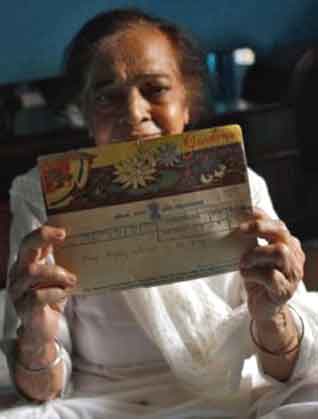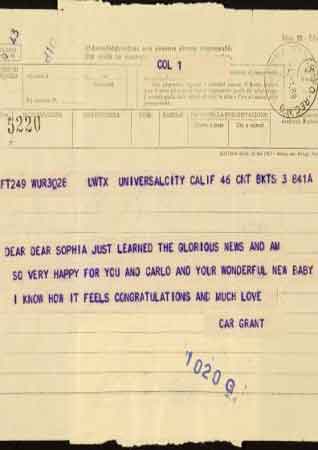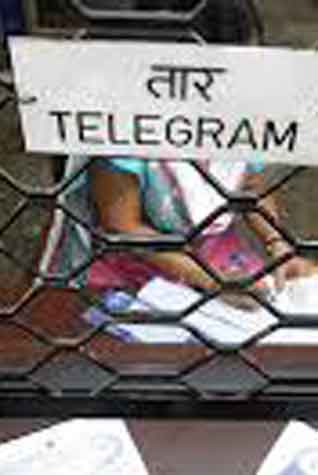
Above: Surjeet Kaur, 77, displays a telegram which was sent by her husband on her birthday in 1955. (Photo: Mansi Thapliyal/Reuters). Below: copy of the telegram Cary Grant sent to Sophia Loren on the birth of her baby.


Current Events
Na Taar, Na Chitthi:
No More Telegrams - or Letters Either
PRITAM SINGH BHULLAR & RAHUL SINGH BEDI
“Is chitthi nu taar samajna" - “Treat this letter as a telegram“.
To emphasise the urgency of the contents of a letter, its writer would often use this phrase in the olden days.
The "taar" (telegram) breathed its last, after 163 years of eventful existence in India, on July 14, 2013. After putting it in the grave, we have performed its requiem service with tearful eyes.
There was a time when this was the only mode of fast communication for our news, good and bad. On reaching your door, the telegraph department man shouted "Taar!" and this sent shock waves down your spine.
You signed for, and opened the telegram with trembling hands, fearing that it might carry some bad news.
We were setting out on a night exercise on September 11 in 1964, when I received a telegram, informing me about the death of my grandfather. I was second-in-command of an infantry battalion at Kota in Rajasthan then. My wife and i caught the night train and reached Batala in Punjab in the morning.
The congratulatory telegrams on my wedding in March 1955 left another indelible imprint on my mind.
No wonder, hundreds of people -- mostly of my generation -- thronged the telegraph offices last Sunday. on July 14, to send their last telegram to their near ones, while bidding a goodbye to this memorable service with a heavy heart.
Its slow-moving sister, "chitthi" (letter) has also lost its erstwhile attraction, thanks to the courier service, e-mail and short message service (SMS) on the mobile telephone, all of which are much faster modes of communication today.
Letter writing had its own charm and advantage of conveying the written word with a personal touch, especially to a loved one. A visit by the postman, and his taking out the letter from his bag, our opening and then reading it out, had its own delight.
A letter from one's wife, which brought all the home news when one was in the field area in the army, had its own unexplainable pleasure.
But this service is also dying out now as the ‘mobile’ phone has become as important for a soldier as his personal weapon. Seemingly, the speed post, which is a much quicker means of taking across your letter to the addressee, will keep the postal mail service going at least for the foreseeable future. But this service cannot be operated in field areas.
How can I forget the chitthis which carried my articles and fixed columns in the eighties and nineties, typed on the portable and imported typewriter bought by my father for a few chips in 1930?
My heart goes out in praise of the efficiency of the postal services as I still remember that at times an article dispatched on Monday, appeared in a local English daily on Wednesday.
Undoubtedly, the present day services such as e-mail, internet and mobile telephone are fast and fit in well in today's fast-moving world.
But do think of the headache that a mobile telephone creates for you because you cannot even have your meal in peace.
Admittedly, the "taar" and "chitthi" have had their heyday. When people were more relaxed, had time to spare … and were happier … than the present generation.
BRIEF HISTORY OF THE TELEGRAM IN INDIA
by Rahul Singh Bedi
William Brooke O’Shaughnessy, an Irish surgeon and inventor who had joined the British East India Company army in Calcutta, was asked by Governor General Lord Dalhousie to lay the first telegraph line from the city to Diamond Harbour, some 13 miles away.
In 1850 he successfully transmitted his first message and within a few years this network of copper wires atop iron rods supported by bamboos extended some 4,000 miles across India.
It criss-crossed its way through thick jungles, across roaring rivers and snow- capped Himalayan mountains, its communications pathways joining up the country. Along with the railway system, the telegraph network further established the sway of the British empire.
In 1857 the company army used the telegraph to help defeat the skirmishes which came to be known as the Indian Mutiny.
[Courtesy: Tribune and The Irish Times. Edited for sikhchic.com]
July 16, 2013


